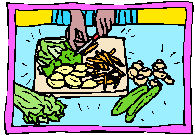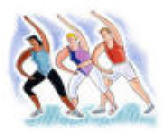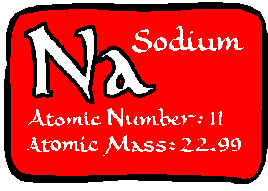Diabetes blog
 The following article is a small excerpt from one of my books. I hope you’ll want to learn more and let me help you to get into the best shape of your life.
The following article is a small excerpt from one of my books. I hope you’ll want to learn more and let me help you to get into the best shape of your life.
Diabetes is a growing health problem and has risen about six-fold since 1950, affecting approximately 16 million Americans. About one-third of these 16 million do not know that they have the disease. Diabetes and its related health care costs total nearly $100 billion per year and rising. Diabetes contributes to over 200,000 deaths each year.
To understand diabetes, you first need to know how your body uses a hormone called insulin to handle glucose, a simple sugar that is your body’s main source of energy. In diabetes, something goes wrong in your body so that you do not produce insulin or are not sensitive to it. Therefore, your body produces high levels of blood glucose, which acts on many organs to produce the symptoms of the disease. Since diabetes is a disease that affects your body’s ability to use glucose, let’s start by looking at what glucose is and how your body controls it.
Glucose is a simple sugar that provides energy to all of the cells in your body. Your cells then take in glucose from your blood and break it down for energy. Brain cells and red blood cells rely solely on glucose for fuel. The glucose in your blood comes from the food you eat.
When you eat food, glucose gets absorbed from your intestines and is distributed by the bloodstream to all of the cells in your body. Your body tries to keep a constant supply of glucose for your cells by maintaining a constant glucose concentration in your blood, otherwise your cells would have more than enough glucose right after a meal and starve in between meals and overnight. So, when you have an oversupply of glucose, your body stores the excess in your liver and muscles by making glycogen, long chains of glucose. When glucose is in short supply, your body mobilizes glucose from stored glycogen and/or stimulates you to eat food. The key is to maintain a constant blood-glucose level.
To maintain a constant blood-glucose level, your body relies on two hormones produced in your pancreas that have opposite actions: insulin and glucagon.
Insulin is made and secreted by the beta cells of the pancreatic islets, small islands of endocrine cells in your pancreas. Insulin is a protein hormone that contains 51 amino acids. Insulin is required by almost all of your body’s cells, but its major targets are liver cells, fat cells and muscle cells. For these cells, insulin does the following:
- Stimulates liver and muscle cells to store glucose in glycogen
- Stimulates fat cells to form fats from fatty acids and glycerol
- Stimulates liver and muscle cells to make proteins from amino acids
- Inhibits the liver and kidney cells from making glucose from intermediate compounds of metabolic pathways (gluconeogenesis)
So insulin stores nutrients right after a meal by reducing the concentrations of glucose, fatty acids and amino acids in the bloodstream.
So when you don’t eat, your pancreas releases glucagon so that your body can produce glucose. Glucagon is another protein hormone that is made and secreted by the alpha cells of the pancreatic islets. Glucagon acts on the same cells as insulin, but has the opposite effects:
- Stimulates the liver and muscles to break down stored glycogen (glycogenolysis) and release the glucose
- Stimulates gluconeogenesis in the liver and kidneys
In contrast to insulin, glucagon mobilizes glucose from stores inside your body and increases the concentrations of glucose in your bloodstream, stopping your blood glucose levels from falling to dangerously low levels.
Normally, the levels of insulin and glucagon are counter-balanced in your bloodstream. Just after you eat a meal, your body is ready to receive the glucose, fatty acids and amino acids absorbed from the food. The presence of these substances in your intestine stimulates the pancreatic beta cells to release insulin into your blood and inhibit the pancreatic alpha cells from secreting glucagon. The levels of insulin in your blood begin to rise and act on cells (particularly liver, fat and muscle) to absorb the incoming molecules of glucose, fatty acids and amino acids. This action of insulin prevents the blood-glucose concentration (as well as the concentrations of fatty acids and amino acids) from substantially increasing in the bloodstream. In this way, your body maintains a steady blood-glucose concentration.
In contrast, when you are between meals or sleeping, your body is essentially starving. Your cells need supplies of glucose from the blood in order to keep going. During these times, slight drops in blood-sugar levels stimulate glucagon secretion from the pancreatic alpha cells and inhibit insulin secretion from the beta cells. Blood-glucagon levels rise. Glucagon acts on liver, muscle and kidney tissue to mobilize glucose from glycogen or to make glucose that gets released into your blood. This action prevents the blood-glucose concentration from falling drastically.
The interplay between insulin and glucagon secretions throughout the day helps to keep your blood-glucose concentration constant, staying at about 90 mg per 100 ml of blood.
Diabetes is classified into three types: Type 1, Type 2 and gestational diabetes.
Type 1 (also called juvenile diabetes or insulin-dependent diabetes) is caused by a lack of insulin. This type is found in five to 10 percent of diabetics and usually occurs in children or adolescents. Type 1 diabetics have an abnormal glucose-tolerance test and little or no insulin in their blood. In Type 1 diabetics, the beta cells of the pancreatic islets are destroyed, possibly by the person’s own immune system, genetic or environmental factors.
Type 2 (also called adult-onset diabetes or non-insulin-dependent diabetes) occurs when your body does not respond or can’t use its own insulin (insulin resistance). Type 2 occurs in 90 to 95 percent of diabetics and usually occurs in adults over the age of 40, most often between the ages of 50 and 60. Type 2 diabetics have an abnormal glucose-tolerance test and higher than normal levels of insulin in their blood. In Type 2 diabetics, the insulin resistance is linked to obesity, but no one is exactly sure how this occurs. Some studies suggest that the number of insulin receptors on liver, fat and muscle cells is reduced, while others suggest that the intracellular pathways activated by insulin in these cells are altered.
Gestational diabetes can occur in some pregnant women and is similar to Type 2 diabetes. Gestational diabetics have an abnormal glucose-tolerance test and slightly higher levels of insulin. During pregnancy, several hormones partially block the actions of insulin, thereby making the woman less sensitive to her own insulin. She develops diabetes that can be managed by special diets and/or supplemental injections of insulin. It usually goes away after the baby is delivered.
Regardless of the type of diabetes, diabetics exhibit several (but not necessarily all) of the following symptoms:
- excessive thirst
- Frequent urination
- Extreme hunger or constant eating
- Unexplained weight loss
- Presence of glucose in the urine
- Tiredness or fatigue
- Changes in vision
- Numbness or tingling in your hands and feet
- Slow-healing wounds or sores
- Abnormally high frequency of infection
When you have diabetes, your lack of insulin or insulin resistance directly causes high blood-glucose levels during fasting and after a meal (reduced glucose tolerance).
- Because your body either does not produce or does not respond to insulin, your cells do not absorb glucose from your bloodstream, which causes you to have high blood-glucose levels.
- Because your cells have no glucose coming into them from your blood, your body thinks that it is starving
- Your pancreatic alpha cells secrete glucagon, and glucagon levels in your blood rise.
- Glucagon acts on your liver and muscles to breakdown stored glycogen and release glucose into the blood.
- Glucagon also acts on your liver and kidneys to produce and release glucose by gluconeogenesis.
- Both of these actions of glucagon further raise your blood-glucose levels.
High blood glucose causes glucose to appear in your urine.
- High blood-glucose levels increase the amount of glucose filtered by your kidneys.
- The amount of glucose filtered exceeds the amount that your kidneys can reabsorb.
- The excess glucose gets lost into the urine and can be detected by glucose test strips)
High blood glucose causes you to urinate frequently.
- High blood glucose increases the amount of glucose filtered by your kidneys.
- Because the filtered load of glucose in your kidneys exceeds the amount that they can reabsorb, glucose remains inside the tubule lumen
- The glucose in the tubule retains water, which increases urine flow through the tubule.
- The glucose in the tubule retains water, which increases urine flow through the tubule.
The high blood glucose and increased urine flow make you constantly thirsty.
- High blood-glucose levels increase the osmotic pressure of your blood and directly stimulate the thirst receptors in your brain.
- Your increased urine flow causes you to lose body sodium, which also stimulates your thirst receptors.
You are constantly hungry. It’s not clear exactly what stimulates your brain’s hunger centers, possibly the lack of insulin or high glucagon levels.
You lose weight despite the fact that you are eating more frequently. The lack of insulin or insulin-resistance directly stimulates the breakdown of fats in fat cells and proteins in muscle, leading to weight loss.
Metabolism of fatty acids leads to the production of acidic ketones in the blood (ketoacidosis), which can lead to breathing problems the smell of acetone on your breath, irregularities in your heart and central-nervous-system depression, which leads to coma.
You feel tired because your cells cannot absorb glucose, leaving them with nothing to burn for energy.
Your hands and feet may feel cold because your high blood-glucose levels cause poor blood circulation.
- High blood glucose increases the osmotic pressure of your blood.
- The increased osmotic pressure draws water from your tissues, causing them to become dehydrated
- The Water in your blood gets lost by your kidneys as urine, which decreases your blood volume.
- The decreased blood volume makes your blood thicker (higher concentration of red blood cells), with a consistency like molasses, and more resistant to flow (poor circulation)
Your poor blood circulation causes numbness in your hands and feet, changes in vision, slow-healing wounds and frequent infections. High blood glucose or lack of insulin may also depress your immune system. Ultimately, these can lead to gangrene in the limbs and blindness.
As of now, there is no cure for diabetes; however, the disease can be treated and managed successfully. The key to treating diabetes is to closely monitor and manage your blood-glucose levels through exercise, diet and medications. The exact treatment regime depends on the type of diabetes.
If you have Type 1 diabetes, you lack insulin and must administer it several times each day. Insulin injections are usually timed around meals to cope with the glucose load from digestion. You must monitor your blood-glucose levels several times a day and adjust the amounts of insulin that you inject accordingly. This keeps your blood-glucose concentration from fluctuating wildly.
There are some implantable insulin infusion pumps that allow you to press a button and infuse insulin. If you inject too much insulin, you can drive your blood-glucose level well below normal (hypoglycemia). This can cause you to feel light-headed and shaky because your brain cells are not receiving enough glucose (mild episodes can be relieved by eating a candy bar or drinking juice). If your blood glucose goes really low, you can lapse into a coma (insulin shock), which can be life threatening. In addition to insulin injections, you have to watch your diet to keep track of the carbohydrate and fat contents, and you must exercise frequently. This treatment continues for the rest of your life.
If you have Type 2 diabetes, you can usually manage it by reducing your body weight through dieting and exercise. You may have to monitor your blood glucose either daily or just when you visit your doctor. Depending on the severity of your diabetes, you may have to take medication to aid in controlling your blood glucose. Most of the medicines for Type 2 diabetes are oral medications, and their actions fall into the following categories:
- Stimulating the pancreas to release more insulin to help reduce blood glucose
- Interfering with the absorption of glucose by the intestine, thereby preventing glucose from entering the bloodstream
- Improving insulin sensitivity
- Reducing glucose production by the liver
- Helping to breakdown or metabolize glucose
- Supplementing insulin directly in the bloodstream through injections
I know you want to get in shape and look great. Whatever your fitness goal…to slim down…gain muscle…tone your arms or flatten your tummy…I’m here to help you accomplish your goals and to improve your fitness level. If you have enjoyed this article and the many other free features on my site, and would like some more comprehensive information such as fitness books and CD’s to aid you in achieving your health and fitness goals, please visit my ONLINE STORE where you will find innovative natural health and beauty products to help you become the BEST YOU CAN BE !


 The following article is a small excerpt from one of my books. I hope you’ll want to learn more and let me help you to get into the best shape of your life.
The following article is a small excerpt from one of my books. I hope you’ll want to learn more and let me help you to get into the best shape of your life. The following article is a small excerpt from one of my books.I hope you’ll want to learn more and let me help you to get into the best shape of your life.
The following article is a small excerpt from one of my books.I hope you’ll want to learn more and let me help you to get into the best shape of your life. The following article is a small excerpt from one of my books. I hope you’ll want to learn more and let me help you to get into the best shape of your life.
The following article is a small excerpt from one of my books. I hope you’ll want to learn more and let me help you to get into the best shape of your life. The following article is a small excerpt from one of my books. I hope you’ll want to learn more and let me help you to get into the best shape of your life.
The following article is a small excerpt from one of my books. I hope you’ll want to learn more and let me help you to get into the best shape of your life. The following article is a small excerpt from one of my books. I hope you’ll want to learn more and let me help you to get into the best shape of your life.
The following article is a small excerpt from one of my books. I hope you’ll want to learn more and let me help you to get into the best shape of your life. The following article is a small excerpt from one of my books. I hope you’ll want to learn more and let me help you to get into the best shape of your life.
The following article is a small excerpt from one of my books. I hope you’ll want to learn more and let me help you to get into the best shape of your life. The following article is a small excerpt from one of my books. I hope you’ll want to learn more and let me help you to get into the best shape of your life.
The following article is a small excerpt from one of my books. I hope you’ll want to learn more and let me help you to get into the best shape of your life. The following article is a small excerpt from one of my books. I hope you’ll want to learn more and let me help you to get into the best shape of your life.
The following article is a small excerpt from one of my books. I hope you’ll want to learn more and let me help you to get into the best shape of your life.